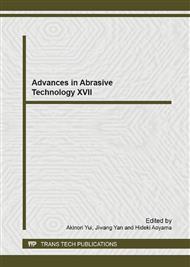p.3
p.9
p.15
p.21
p.27
p.33
p.38
p.44
Study on Grinding Force Distribution on Cup Type Electroplated Diamond Wheel in Face Grinding of Cemented Carbide
Abstract:
In order to establish a high performance grinding method of cemented carbide, the grinding force distribution on the working surface of the cup type electroplated diamond grinding wheel is experimentally analyzed with the grinding force variation of face grinding, which is carried out on the narrow workpiece. The grinding force distribution is obtained by the successive difference of the grinding force variation. The grinding state becomes steady as soon as beginning of the interference of grinding wheel in workpiece, because the edge profile of workpiece is formed as same as the envelope of the grinding wheel. Main conclusions obtained in this study are as follows. In the region of the front edge of the grinding wheel, relatively large grinding force occurs, then in the region of the rear edge of the grinding wheel, the grinding force becomes smaller. In the left right-side end of the wheel, the grinding forces are larger than the center of the wheel. It is made clear that the grinding force distribution shows the peak value near the outer part of the wheel, and the peak value is larger in the center part of the wheel, on the contrary, the peak width become broad in both the left and right-side end of the wheel.
Info:
Periodical:
Pages:
9-14
Citation:
Online since:
September 2014
Authors:
Price:
Сopyright:
© 2014 Trans Tech Publications Ltd. All Rights Reserved
Share:
Citation:


